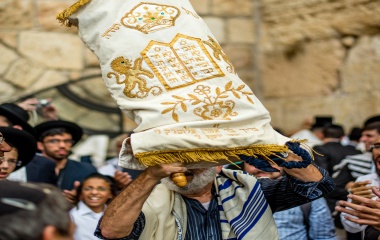
"On the Yom Tov of the last day, we read 'Kol Habechor, every first born'" (Devarim 15:19, Megillah 31a). Finding an appropriate Torah reading for Shmini Azeret is no easy task. The holiday is mentioned only twice in Chumash: once as a passing reference in Parshat Emor, where the Torah instructs us to keep Sukkot for seven days and "the eighth day shall be a holy convocation" (Vayikra 23:36), and once in Parshat Pinchas, where the sacrifices of the day are mentioned (and which serves as the Maftir reading). We are left wondering why we celebrate this holiday, which has neither historical nor agricultural significance.
Parshat Emor served as the Torah reading on the first two days of Sukkot (one in Israel) and, coupled with its very brief mention of Shemini Azeret, was bypassed as the Torah reading. The parsha of kol habechor seems to win by process of elimination. While it does not discuss Shemini Azeret--the term azeret is used in this parsha to describe the seventh day of Pesach--it does discuss the three pilgrim festivals of Pesach, Shavuot, and Sukkot. The Oral Law teaches that, unlike at Pesach, pilgrims must remain in Jerusalem for this eighth day (Sukkah 48a). It also teaches that the verse "v'hayeeta ach sameach (Devarim 16:15), and you shall only be happy" is a reference to the night of Shemini Azeret (Pesachim 71a).
But what to read on the second day of Yom Tov? "And on the next day (in the time of the Talmud, the vast majority of Jews lived in the Diaspora) we read V'zot Haberacha." This reading may seem an obvious choice, with Simchat Torah being the day we complete the annual cycle of the Torah reading. However, such an explanation, while most reasonable today, is anachronistic. In the time of the Talmud, Simchat Torah did not yet exist, and the annual cycle of Torah reading had not been fully adopted.
Furthermore, the listing of the Torah portions to be read on the holidays were meant to be read in place of the regular parshat hashavua, so that V'zot Haberacha was read not because we read Haazinu the prior week, but because of its connection to Shmini Azeret. In other words, regardless of where a particular community may have been on in their Torah reading cycle, on the second day of Shmini Azeret they were to read V'zot Haberacha. But why?
Perhaps most simply, V'zot Haberacha recounts the blessings of Moshe to each of the tribes (with the exception of Shimon[1]), and is most appropriate at the time of harvest, when we rejoice in our blessings. Perhaps it was chosen because of the verse "He became King of Jeshurun" (Devarim 33:5), thereby linking Shemini Azeret to Rosh Hashanah, where the coronation of G-d is the major theme. Or perhaps we wanted to link Shemini Azeret to Yom Kippur (and Rosh Hashanah), reminding us of how Moshe's sin caused him to die before he could achieve his dream of entering the land of Israel[2].
min hamyim mesheetehu" (Shemot 2:10). And due to his "sin" in drawing water from the rock, he was destined to die in the desert.
It is water that is a--perhaps the--major theme of (Sukkot and) Shemini Azeret. "And on the Chag [of Sukkot], the world is judged regarding water" (Rosh Hashana 16a). It is the time of nisuch hamayim, the water libations on the altar, the time we pray for rain and the time we begin reciting masheev haruach u'moreed hageshem. Even the shaking of the lulav is a prayer that the rains should be for a blessing.
It is our custom--one not mentioned in the Talmud--to add an additional Torah reading on this day. "In the beginning...G-d's spirit moved on the water's surface." Only afterwards was light created. Both day two and three focus on water, a dual creation we find nowhere else.
G-d gave the Jewish people the land of Israel precisely because there was precious little water, forcing us to be dependent on G-d for our water (see Devarim 11:12). Water became the medium through which G-d communicated with us and through which we developed our relationship with Him. Having such a close connection to G-d can be frightening, but is the source of great happiness. May we merit to rejoice with the Torah and feel the presence of G-d as we celebrate Simchat Torah.
[1] This little known fact is most likely due to the tribe of Shimon leading the way in sinning with the daughters of Midian (see Bamidbar 25:1-15 and Rashi, Devarim 33:7).
[2] The links to Rosh Hashanah and Yom Kippur are not coincidental. The korbanot Mussaf for Shemini Azeret are exactly the same ones brought on Rosh Hashanah and Yom Kippur, and not, as I may have expected, the same ones as those brought on Pesach and Shavuot (or even Rosh Chodesh).
[3] For another explanation see the last comment of the Mesech Chochma to Vzot Haberacha.



